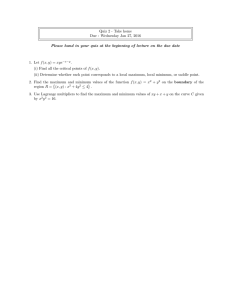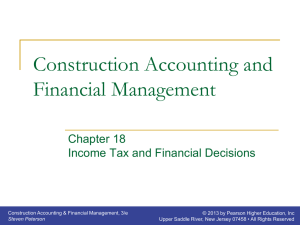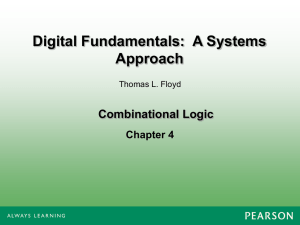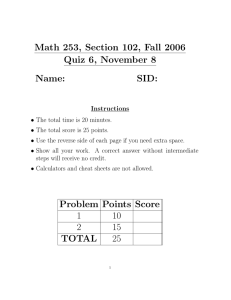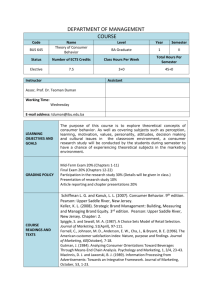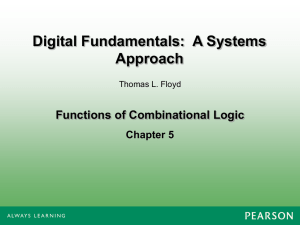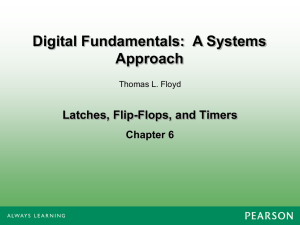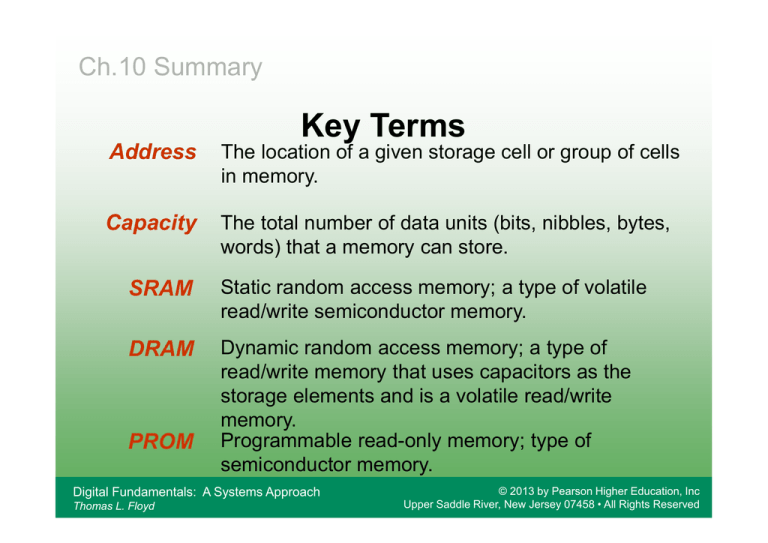
Ch.10 Summary
Key Terms
Address
The location of a given storage cell or group of cells
in memory.
Capacity
The total number of data units (bits, nibbles, bytes,
words) that a memory can store.
SRAM
Static random access memory; a type of volatile
read/write semiconductor memory.
DRAM
Dynamic random access memory; a type of
read/write memory that uses capacitors as the
storage elements and is a volatile read/write
memory.
Programmable read-only memory; type of
semiconductor memory.
PROM
Digital Fundamentals: A Systems Approach
Thomas L. Floyd
© 2013 by Pearson Higher Education, Inc
Upper Saddle River, New Jersey 07458 • All Rights Reserved
Ch.10 Summary
Key Terms
EPROM
Erasable programmable read-only memory; a type
of semiconductor memory device that typically
uses ultraviolet light to erase data.
Flash memory A nonvolatile read/write random access
semiconductor memory in which data are stored
as charge on a floating gate of a certain type of
FET.
FIFO
LIFO
Hard disk
First in-first out memory.
Last in-first out memory
A magnetic storage device; typically a stack of two
or more rigid disks enclosed in a sealed housing.
Digital Fundamentals: A Systems Approach
Thomas L. Floyd
© 2013 by Pearson Higher Education, Inc
Upper Saddle River, New Jersey 07458 • All Rights Reserved
Ch.10 Summary
Quiz
1. Static RAM is
a. nonvolatile read only memory
b. nonvolatile read/write memory
c. volatile read only memory
d. volatile read/write memory
Digital Fundamentals: A Systems Approach
Thomas L. Floyd
© 2013 by Pearson Higher Education, Inc
Upper Saddle River, New Jersey 07458 • All Rights Reserved
Ch.10 Summary
Quiz
2. A nonvolatile memory is one that
a. requires a clock
b. must be refreshed regularly
c. retains data without power applied
d. all of the above
Digital Fundamentals: A Systems Approach
Thomas L. Floyd
© 2013 by Pearson Higher Education, Inc
Upper Saddle River, New Jersey 07458 • All Rights Reserved
Ch.10 Summary
Quiz
3. The advantage of dynamic RAM over static RAM
is that
a. it is much faster
b. it does not require refreshing
c. it is simpler and cheaper
d. all of the above
Digital Fundamentals: A Systems Approach
Thomas L. Floyd
© 2013 by Pearson Higher Education, Inc
Upper Saddle River, New Jersey 07458 • All Rights Reserved
Ch.10 Summary
Quiz
4. The first step in a read or write operation for a
random access memory is to
a. place a valid address on the address bus
b. enable the memory
c. send or obtain the data
d. start a refresh cycle
Digital Fundamentals: A Systems Approach
Thomas L. Floyd
© 2013 by Pearson Higher Education, Inc
Upper Saddle River, New Jersey 07458 • All Rights Reserved
Ch.10 Summary
Quiz
5. The output enable signal (OE) on a RAM is
active
a. only during a write operation
b. only during a read operation
c. both of the above
d. none of the above
Digital Fundamentals: A Systems Approach
Thomas L. Floyd
© 2013 by Pearson Higher Education, Inc
Upper Saddle River, New Jersey 07458 • All Rights Reserved
Ch.10 Summary
Quiz
6. When data is read from RAM, the memory
location is
a. cleared after the read operation
b. set to all 1’s after the read operation
c. unchanged
d. destroyed
Digital Fundamentals: A Systems Approach
Thomas L. Floyd
© 2013 by Pearson Higher Education, Inc
Upper Saddle River, New Jersey 07458 • All Rights Reserved
Ch.10 Summary
Quiz
7. An EPROM has a window to allow UV light to enter
under certain conditions. The purpose of this is to
a. refresh the data
b. read the data
c. program the IC
d. erase the data
Digital Fundamentals: A Systems Approach
Thomas L. Floyd
© 2013 by Pearson Higher Education, Inc
Upper Saddle River, New Jersey 07458 • All Rights Reserved
Ch.10 Summary
Quiz
8. The small triangles on the logic diagram indicate
that these outputs are
a. not used
b. tri-stated
Address
input lines
A0
A1
A2
c. inverted
d. grounded
A3
A4
A5
A6
A7
Data
output
lines
O0
O1
O2
O3
E0
E1
Digital Fundamentals: A Systems Approach
Thomas L. Floyd
© 2013 by Pearson Higher Education, Inc
Upper Saddle River, New Jersey 07458 • All Rights Reserved
Ch.10 Summary
Quiz
9. Using two ICs as shown will expand
a. the word size
b. the number of words available
c. both of the above
d. none of the above
Digital Fundamentals: A Systems Approach
Thomas L. Floyd
© 2013 by Pearson Higher Education, Inc
Upper Saddle River, New Jersey 07458 • All Rights Reserved
Ch.10 Summary
Quiz
10. On a hard drive. information about file names,
locations, and file size are kept in a special location
called the
a. file location list
b. file allocation table
c. disk directory
d. stack
Digital Fundamentals: A Systems Approach
Thomas L. Floyd
© 2013 by Pearson Higher Education, Inc
Upper Saddle River, New Jersey 07458 • All Rights Reserved
Ch.10 Summary
Answers
Digital Fundamentals: A Systems Approach
Thomas L. Floyd
1. d
6. c
2. c
7. d
3. c
8. b
4. a
9. a
5. b
10. b
© 2013 by Pearson Higher Education, Inc
Upper Saddle River, New Jersey 07458 • All Rights Reserved

